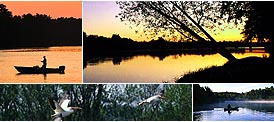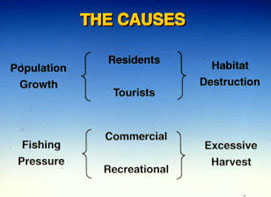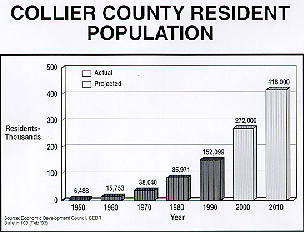

Alligator Hunting: A One of a Kind Experience -
Why They Call it Hunting Instead of Killing -
Florida's Other Crab - by Kris Thoemke
The Waiting Game - by Kris Thoemke
Mounted Memories - by Kris Thoemke
Eco-Touring in Collier County - by Kris Thoemke
Beyond the Largemouth Bass - by Kris Thoemke
Tying One On -- Some thoughts on how to get started tying your own flies -- by Kris Thoemke
The Big Cypress: Adventures in a Vast Wilderness
A Basic Guide to Saltwater Fly Fishing in Southwest Florida -- by Don Phillips
Four Strokes on the Water -- The sound of the future for marine outboards is likely to be much quieter --
Birding Big Cypress Swamp and the 10,000 Islands --
Recycling Your Fish -- by Kris Thoemke
Peace, Paddle and Hunt -- by Kris Thoemke
by Kris Thoemke
by Kris Thoemke
-- Kris Thoemke spends the day exploring the Big Cypress National Preserve with Preserve biologist Debra Jansen
by Kris Thoemke
by natural history writer and photographer Jeff Ripple
A Basic Guide to Saltwater Fly Fishing in Southwest Florida
© 1997, Don Phillips
Chapter 12 - Conservation
The previous eleven chapters have centered around the tackle, tools and techniques of our trade.
In this final chapter I'd like to express my concerns about the future for quality fly fishing in
southwest Florida, and ways in which we can help to work toward a favorable outcome. Twenty
five to fifty years ago many saltwater anglers around the USA would scoff at proposed
conservation measures, claiming that the oceans contain a limitless source of fish for food or
sport. Now, dozens of species are threatened with extinction and many more are experiencing
serious population declines.

The reasons for these declines are essentially three-fold; habitat destruction, pollution and over-harvesting. Let's discuss each of these factors in some detail, as they specifically relate to
southwest Florida.
Our shoreline is changing markedly and rapidly, as we attempt to accommodate the interests of
residents and visitors alike. We renourish our beaches to provide more space for recreation, at
the same time changing the nearshore bottom topography and altering tidal flow channels in as
yet unknown ways. We dredge shallow passes to enable the travel of larger and larger boats,
loading the tidal flow with silt which blankets the lower life forms. We remove mangrove
shoreline and replace it with concrete seawalls, thus denying dozens of fish and crustacean
species the protection and food that they need for survival. We construct canals to increase the
number and value of homesites, at the same time denying natural sheet flow from the soil to the
gulf which cleanses the water and establishes the critical salinity gradient needed by most
backwater life forms. We race our boats and jet skis across fragile flats, destroying the grassy
cover needed by many species. Figuratively speaking, we fly fishers are "chained" to the
backwater/nearshore environment and thus we see this habitat destruction ( and its effect on fish
populations) up close and personal. The offshore fisherman sees the population decline later
because most offshore species rely on the backwater "nursery" for food and/or specie
propagation.
Inshore, similar ecological disruption is taking place in the name of progress. Our ground area is
being paved, highways and roads are damming natural sheet flow, low areas are being filled,
dams and weirs are creating artificial inland flow patterns and exotic trees are sucking the water
away from thirsty native species. All of these actions are disturbing the natural path of rainwater
from air to ground to swamp and to estuary. Instead, the rainwater runs off rapidly into canals
and creeks and then floods the estuaries with an abnormal percent of fresh water. Or, the water is
lost through irrigation, consumption and evaporation. A little over a year ago I listened to an
interesting talk by an individual studying the species of lifeforms now present in Rookery Bay
(near Marco Island), compared to a similar study a few decades ago. This research clearly
showed that some species are not around any more and that a few new ones have shown up.. Is
this part of nature's "evolution"? I think not. These rather subtle changes are taking place all the
time; the general public is not aware of it and none of us know the eventual implications.
The pollutants that are invading our waterways on a continuing basis include fuel/oil residue,
treated/untreated sewage, agricultural/landscaping runoff (nitrates, phosphates, pesticides), heavy
metals and trash. The Collier County Health Department has confirmed that all of these
pollutants are present in Naples Bay, some to an alarming degree. Each year, volunteers pick up
several tons of general trash from the Naples Bay area, all in one cleanup day! Over 70 water
areas in South Florida have been posted for dangerous levels of Mercury, a bad actor in the heavy
metals category. Pollution is a silent killer, because it takes expensive sampling and
measurement to determine its presence, after the fact. For those people that eat fish (probably
99% of us), the risks of illness are very real. Even if a fish was caught offshore or down south in
the 10,000 Islands it may have spent earlier years surviving in a polluted environment. Our clam
industry left southwest Florida a long time ago. These bivalves are noted for their early-warning
features; sort of our "canary-in-the-mine".

Over-harvesting is another factor which is threatening our fish populations. This photograph was
taken several years ago, but we all see similar evidence of the so-called prowess of our fishing
skills. We can't keep it up and expect our fishing to be good in the future. The inshore net ban
which was effective on July 1995 has already begun to show improvement in our fish
populations, but illegal netting continues and legal offshore netting continues to plunder the seas.
One of the fundamental underlying problems is Collier County's explosive population growth .
Note this chart prepared from data provided by the County's Long-Range Planning Department.
As the nation's second fastest-growing region, we are almost doubling in size every ten years!
And then add another 30-40% to these numbers for vacationers during the peak season. Since
around 25% of residents and vacationers fish, you can see where we're heading. Development and services are of course expanding to meet this need and I see little evidence that this
expansion is part of a master plan that gives proper attention to the environment, especially our
fish populations.
and services are of course expanding to meet this need and I see little evidence that this
expansion is part of a master plan that gives proper attention to the environment, especially our
fish populations.
Realistically, I expect that I'll enjoy quality fly fishing in southwest Florida for the remainder of
my lifetime. I'm concerned however for my children and grandchildren and their ability to enjoy
the treasures of our area. In spite of my concerns stated above, I'm not an environmental
extremist or "tree-hugger". I believe that we can stem this tide by dialogue, compromise and
actions if a long-range plan can be first drafted that is acceptable to a majority of our county
voters. Local, county and State governments must treat this with a sense of urgency, or the
reasons why we're all here will be history. Without a publicly-supported, comprehensive long-range plan we will continue to shout about issues with no basis for common ground.
As citizens, it is up to us to elect local, county and state governments which will evolve and
implement such a plan and to participate in government through hearings, advisory committees
and elective office. Beyond that however there's much more to do. First, we can be pro-active in
questioning new development ventures and insisting that the health of the environment,
especially the water, be properly considered. Stand up and speak out about bad development
practices, pollution sources, illegal netting and sportfishing, etc. Only if enough of us raise our
voices will the trend be reversed.
For those of us who fish, we can directly affect fish conservation by limiting the number of fish
we kill. Many of us practice catch-and-release most if not all of the time. If you do catch fish for
the table, do so legally and don't kill any more fish than can be consumed by your family in the
next day or two. When releasing fish, handle them as little as possible, to ensure that they will
survive the experience. Using barbless hooks greatly facilitates the release. Fly fishers that use
forceps to grasp the fly while the fish is still in the water can often release the fish without
touching it. If the fish exhibits some degree of distress, hold it level in the water and move it
back and forth to force water through its gills. If it revives, it will swim away on its own.
Finally, try to avoid handling the fish with dry hands; this disturbs the layer of mucus that covers
the fish to protect it from fungus diseases.
If we can all do our share to conserve and preserve our precious resources, future generations of residents and visitors (including fly fishers) will thank us for our stewardship.












